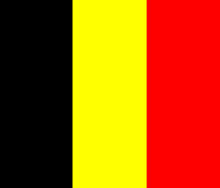We visited many of the sights associated with D-day of course, such as Omaha Beach and the American cemetary, the German cemetary at La Cambe, Pointe du Hoc, Arromanches and the Memorial Museum at Caen. To walk along the very same places I've read about, studied and seen in movies was really moving, and the near perfect weather we had every day except Thursday made the setting beautiful as well. The Normandy landscape is scenic to say the least - rolling hills, wide sandy beaches, jagged cliffs, and postcard perfect countryside complete with cow pastures, apple orchards and fields of yellow rapeseed flowers (it's used to make canola oil).
This region is also full of history from other time periods, particularly the 1100's to the 1400's. The Norman invasion of England in 1066 by William the Conqueror was launched from here, and is commemorated in pictures in the Bayeux tapestry, which we saw in Bayeux. We also visited the square in Rouen where Joan of Arc was burned in 1431. Additionally, we saw several impressive cathedrals in Beauvais, Bayeux and Caen, and the ruins of the Château Gaillard near Rouen.
No trip to the region can be considered complete without seeing the massive and beautiful Mont St. Michel, topped by a beautiful abbey and surrounded by tidal sand/mud flats that can be walked on during low tide, but flood quickly at high tide and over the centuries have claimed the lives of many unwary visitors. The rock formation upon which the abbey is built just seems to rise up out of nowhere, making the place that much more striking against the relatively flat landscape that surrounds it. It's a very popular place to visit so it was very crowded and more than a little bit touristy, but even that couldn't take away from its appeal. It's a definite must-see if you visit Normandy!
Finally, our historical and architectural tour was broken up by visits to a cheese making factory and an apple orchard. The cheese factory, Isigny-Sainte-Mère, makes some fabulous Camembert and Pont l'Evêque cheeses for which Normandy is famous, and which we were able to sample and buy. Beverages made from apples, including alcoholic cidre, calvados (apple brandy), and pommeau (a blend of the cidre and calvados) are also famous in this region, and visiting the orchard was a real treat. The place we visited was a very small production, family-run business, and their products were just amazing - we brought home several bottles of cidre, pommeau and also regular apple juice, in additional to a fabulous jar of confit (very sweet, honey-like consistency spread often used as a marinade).
In case it isn't apparent already, Normandy was just AMAZING, and we had a really wonderful time. If you ever have the chance to visit there, definitely do so!
Picture #1: Looking off the cliff above Arromanches, towards Pont du Hoc. The large objects you see on the beach and out in the water are the remnants of the artificial harbor built by the Allies after the D-day invasion
Picture #2: Looking up the hill from Omaha Beach. This is what the soldiers who came ashore that morning had to climb - under heavy fire, of course.
Picture #3: The remains of the German defense post at Pointe du Hoc. An elite group of 225 Army Rangers, with fire support from ships offshore, had to destroy the powerful guns and concrete fortifications that were here in order to disable the strongest German coastal defense and allow the invasion to go forward. They succeeded, but upon completing their mission less than half of them were alive and unhurt.
Picture #4: view of Mont St. Michel.
Picture #5: The Abbaye aux Hommes (Abbey of Men) at Caen, built by William the Conqueror in the 11th century; 80% of this city was destroyed during the war, but this church was spared because the Allies learned that residents were holed up inside for protection.








1 comment:
Wow looks gorgeous and my mouth is watering over your apple and cheese treats! We'll pull out the calendar soon and figure out when we can come visit!
Post a Comment